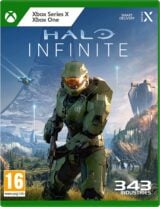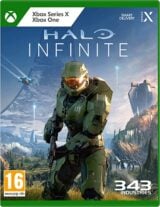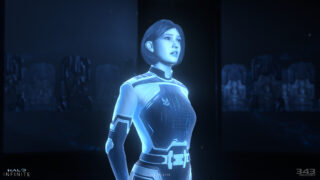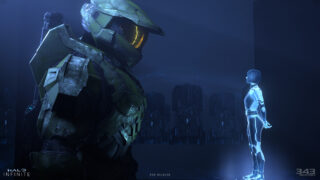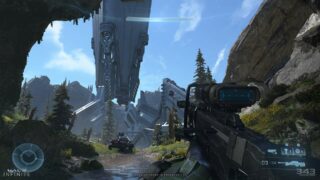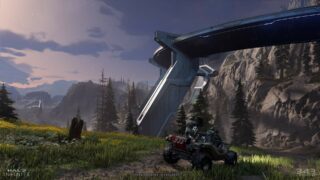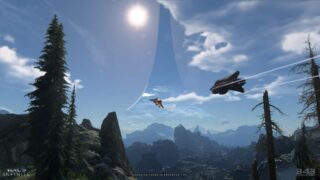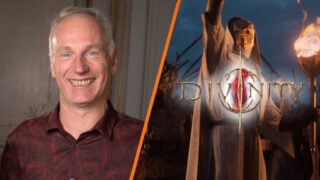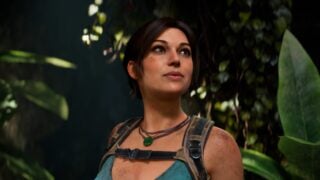Halo campaign interview: ‘We don’t like calling this an open-world game’
343’s Campaign team discuss the delay, move to an open structure and the future

Halo fans got a big surprise this week with the early release of Halo Infinite’s free-to-play multiplayer mode.
However, many fans will be eagerly anticipating the launch of the full campaign mode on December 8.
Recently, VGC was able to play the opening hours of the solo mode and early impressions suggest that the combination of traditional Halo sandbox gameplay with a large, open world could turn out to be a perfect marriage for the series.
The cinematic elements seen in recent games are still very much here, but the freedom, scale and experimentation within the moment-to-moment gameplay feels like a welcome call back to the Bungie classics of old. Hopefully, with further playtime, the activities on offer don’t become repetitive, but it’s looking promising for a strong release.
To find out more about the campaign, we spoke with Paul Crocker (associate creative director), Steve Dyck (character director), Justin Dinges (campaign art lead) and Jeff Easterling (Halo franchise & narrative writer). The questions below were taken from a group of journalists from different media outlets.
How did the extra year help with the development of the Campaign?
Paul Crocker: We looked at the game and because we were lucky to have that extra time, we played it all the way through multiple times, we sat in rooms, we really analysed what we had and we wanted to take the things we already had and make them better.
Sometimes it was an editorial process… we didn’t add a new game, it’s the same game, with more polish because we had more time. We did have a priority order in which we looked at stuff such as the grapple to make sure it was as fun as it possibly can be, to add more tutorialisation to encourage people to use it.
We really doubled down on making sure our bosses were as polished as they can be. They now have introductions where as some of them didn’t in the past. We looked at the story, and added a few more moments. The game’s antagonist got a little more screentime and his boss fight got extra time to polish because it was one of those things that was working really well, but we wanted to push it further, we wanted to create more of an experience.
Stephen Dyck: To me, the biggest thing was time spent with a nearly finished game. We were able to go back and adjust for pacing, and flow, so everything didn’t feel the same and big moments felt like big moments because we cleared some space before them.
The natural tendency is that if you get more time you’re like “we’ve gotta add!” but we didn’t do that, we added very selectively. Most of the time it was reinforcing something and looking at what we had and bringing the quality up whether it be art or gameplay or bringing the performances up. To me, that extra time we got was valuable in the fact that we had a game that was just about done and we could spend time to add to that.
Justin Dinges: On the visuals, we knew we weren’t ready last year when we showed, but we needed to be there for Xbox, we needed to show the gameplay, get people excited. We already had a long list of things we needed to improve and complete and we were fortunate to get that time from Microsoft and Xbox to finish those things and improve those things. We didn’t just start throwing stuff in. We looked and said, “what is the reaction and what are our own thoughts?”
Paul Crocker: I don’t think anyone in the team thought the game was too small, we really worked hard to make the biggest campaign that the studio has ever made, the biggest Halo game, but the goal wasn’t to make the biggest game in the world, it was to make the best Halo game we could using that technology, so we looked at the game we had and we were able to target things, the pacing is the number one thing we had time to go through and look at the game.
What was your approach to building out the open world, and how did the team maintain its storytelling within the structure?
Paul Crocker: First of all, I think it’s important when we looked at making Halo Infinite, that we as a studio looked at it through the lens of a spiritual reboot. We wanted to recreate the feelings people had when they first played Halo 20 years ago and almost how you think about that game vs how it is now when you look at it 20 years later, using modern technology. That meant building this more expansive world.
The reason we tend not to talk about it using “open-world” as a term is that open-world is this genre now where it comes with these different expectations and we wanted to ground everything in making the best Halo experience we could. So what that meant was we created our story that pulls you through. It’s a mystery story that pulls you through with a bunch of questions that are started at the beginning of the game and are answered by the end.
We wanted story to be the thing that gates progress, but then we wanted the player to have all these opportunities for the player to feel like Master Cheif around the world. The way we created all of our outposts and all the other side content was supposed to be a thing that we want you to want to move off that main path to do, but if you’re the kind of player, and we have a large amount of them, who actually just want to do the story first, you can, the story will just pull you through in that straight line through, even though it is an expansive world that lets you go in multiple directions.
And then once we had the golden path in, we then figured out how to add more and more story content at the extremities of that map.
“The reason we tend not to talk about it using ‘open-world’ as a term is that open-world is this genre now where it comes with these different expectations and we wanted to ground everything in making the best Halo experience we could.”
Jeff Easterling: Really, just echoing what Paul said, that kind of freedom of choice went back to that pillar of wanting to make it accessible to new players as well as interesting for old players, so there are a lot of opportunities off the beaten path to explore more about the factions, the protagonist, the antagonists, the characters and the situation the universe finds itself in there.
Stephen Dyck: Like Paul said, it’s not open-world. One of the things that we wanted to avoid was the grindy nature that can come with most open-world games, where you’re going incessantly hunting enemies to level up and upgrade your character. We wanted to avoid that and stay close as possible to true Halo combat. “Super-Soldier based assault” is the term we threw around a lot and if we felt like we were getting away from Chief’s ability to push the action, then we felt like we weren’t really making a Halo game anymore.
So from a combat and gameplay standpoint, we wanted to make sure that everything we did just reinforced that, so yeah you can jump in, you can do what you want to do, whether it’s something in a more linear structure like one of our dungeons, or whether it’s out in the more open areas of the game, you can do what you want, bring whatever weapon you want, whatever vehicle you want and the game’s gonna support that.
So obviously there was a lot of under-the-hood work we had to do to support all the variety that the player can bring… we wanted the variety to come from the player’s side, like hey, it’s up to you, how do you want to attack this thing, are you going to bring a flying vehicle, are you going to bring a Razorback full of Marines, are you gonna go on foot with a rocket launcher and a sniper rifle, any option is equally valid and it’s going to be supported by the gameplay.
Paul Crocker: I think what differentiates us in our goals is the quality of the sandbox. That is the thing that is Halo. So every encounter in the game, no matter how small or big is fun, is tight, is polished, because that’s what the Halo sandbox is known for. It’s that layer of polish on top of that freedom that we are giving you.

Justin Dinges: We didn’t from the get-go say, “let’s go try to make an open-world game”, that was never the goal. The goal was to make the next Halo game and then to echo Paul’s point and Steve’s point, the sandbox generally is what has shined the most and so, how do you embrace that more without losing what you had?
I believe we struck a pretty good balance still having those linear missions and moments and also giving the player a more wide-open space for the player to express themselves through the sandbox, rather than dictating everything that happens, rather than making it so wild and open that you don’t really know what you’re doing anymore. The team really focussed on making the right game for Halo, not just making a big open-world game.
How did the team develop the game with the approach to accommodate new players?
Paul Crocker: There are many layers to that. There’s the narrative layer, the gameplay layer and trying to make the game as inviting as possible. “Inviting” is one of the words we used very early on along with narratively using a seemingly dumb phrase of “green man, blue lady” to really just to… if you squint at Halo, what kind of stuff is important to you?
Obviously, we are lucky because we have a huge amount of players over the last 20 years who have experienced Halo, but we also know that they haven’t necessarily played all of the titles and they also have lives to get on with. We have our hardcore fans that play Halo every day and we have people have maybe haven’t played it for 6 years or maybe 10 years, who have missed all the 343 games.
So we wanted to really reinforce how much fun it is to play a Halo game. I talked about the sandbox before, but truly that’s the heart of Halo, it’s the relationship between green man and blue lady, it’s the sandbox, it’s the freedom you have and I genuinely believe when you put a controller in your hand you feel that on whatever platform we give you.
Then what we did was we looked at how we wanted to create our story. Obviously, we have a lot of history, and the history can be offputting, so we designed our story to put all players, and the characters in story in the same position of not knowing what is going on and allow them to discover through exploration of the world and following the golden path what has happened.
“Obviously, we are lucky because we have a huge amount of players over the last 20 years who have experienced Halo, but we also know that they haven’t necessarily played all of the titles and they also have lives to get on with.”
Our goal was to create new mysteries and to create new narrative threads for the game to go on to in the future. Part of the thing we were talking about yesterday is how similar it is from that perspective it is to Halo: Combat Evolved, because you didn’t know a lot about what the ring was, how it was built. When you first played that game you were in an alien world and exploring it and discovering it at your own pace, and we really wanted to get that feeling back into players’ hands so they got to explore and figure stuff out.
That doesn’t mean we don’t tell you stuff: we do tell you stuff as you go through the game, but it’s about striking that balance between the story pulling you through and the story not stopping you from wanting to explore and do stuff. No one is shouting at you ‘go, go, go!’ But it’s very clearly directed that if you want to, this is where you need to go next, but you have full autonomy to go whenever you want.
Stephen Dyck: Traditionally, Halo’s always been developed on the Heroic difficulty, and we did the same thing for 4 and 5. So usually we look at Heroic, we’re tuning everything here, everything is scaled down a little bit for Normal and Easy and then scaled up a little bit for Legendary.
This time, we spent much more time on the Normal difficulty, expecting new players to come in. That doesn’t mean that Heroic isn’t hard and that Legendary isn’t very punishing, those are things that are still just part of Halo, but we did spend more time on Normal difficulty from the standpoint of, ‘what if you were a new player and you’d never fought the covenant before or you’ve never fought anything in Halo before and it’s your first time using an AR?’
We want those players to have fun and success and not immediately be hit with a wall from a gameplay standpoint where they’re like, “aw man, I haven’t played this, I don’t get it… am I supposed to use a specific damage type here?” Or, “that grenade didn’t do anything, why didn’t it do anything?” So one of the philosophies we’ve had is, the player’s always right or the game says “yes”.

If the player wants to use something or a certain type of weapon, while certain weapons will be more successful, we’re never going to say, “you’re just wrong, you can’t do that”. That’s where I’d say from a gameplay standpoint our philosophy was a little bit different, we were just kind of like – come in, play, we’ll ease into things, we’ll tutorialise things for you especially with the addition of things like equipment and things like that. So ideally, the player has a smoother ramp into the Halo world of gameplay.
Paul Crocker: The golden path is very curated by us. The further away from the golden path you travel, you’ll hit difficulty spikes which are challenges to return to if you fail when you first encounter them. As you engage with equipment upgrades, as you capture more FOBs, as you bring marines, you can bring help with you for those encounters.
Anecdotally, some of the people on the team actually found Normal difficulty a bit harder because it was more open and more 360 degrees of combat, whereas players who play a lot of other titles were finding it very easy, so the balance was making sure it was inviting to all players on Normal difficulty then a guarantee that if you bump up the difficulty, it gets more challenging
Justin Dinges: We got a lot of feedback on 5 that there was a high price of entry into that game of knowing things. So we wanted to make the price of entry into the franchise more available to people, so they didn’t feel that they had to [know things]. That doesn’t mean all that information isn’t there… hopefully, it just doesn’t require you to know that stuff.
Jeff Easterling: The main antagonist, the Banished, have a really cool opportunity to be the best of both worlds. There’s an element of the Banished that some players have encountered in games like Halo Wars 2, but they’re still a fresh element in our universe and there’s still a ton of stuff to explore about their own characters and motivations and things like that too. It helps provide some originality but at the same time a really cool, fresh new palette and slate for players to explore, both new and old.
“Anecdotally, some of the people on the team actually found Normal difficulty a bit harder because it was more open and more 360 degrees of combat, whereas players who play a lot of other titles were finding it very easy”
This time around you’re approaching the storytelling a bit differently with audio logs scattered around the world. How did that come about?
Jeff Easterling: The audio logs were an interesting opportunity for us to tell some of the side stories that aren’t required to enjoy and understand the golden path, but make the world feel lived in and feel real, but maybe help to flesh out some of the stakes.
You know as you’re going through as the Master Chief you’re fighting to save humanity. Sometimes it enhances that experience when you’ve heard from humanity a little bit, you can find a datapad in an outpost or a cave from a group of marines that talk about their struggles in the past few months, or maybe you find something that gives you more insight on the Banished as a faction.
The datapads are all in a radio drama format that go in different story arcs depending on where you’re finding them and what order and where you are in the game. That was the big thing… how can we leverage that storytelling vehicle to make the world feel more lived-in and more real when you jump back on that main path?
The grapple hook movement feels great. But did introducing such a radical ability present challenges in terms of world design?
Paul Crocker: One of the things we do as a studio is that we have a sandbox team creating mechanics for multiplayer and campaign, and we try to share as much as we possibly can. So in the ideation phases of the game, there are a whole bunch of crazy ideas explored and one of them was the grapple shot.
When you first put it in people’s hands there’s hesitancy because it is one of those things that changes how you play which is what you want, but it also introduces problems that we didn’t think of when we developed it. Then we hand it to the team and they work really hard to make sure those mechanics are used in the best possible way across the game

Stephen Dyck: For the environments, we had to accommodate for much more verticality. In previous titles we didn’t worry about that so much mostly because there was no grapple hook and players couldn’t just go where they wanted to go. The team rallied around it and luckily the grapple hook is one of the most exciting things we’ve added to the game so we got really excited about it to make sure the people could do what they want.
Justin Dinges: It’s an extension of Chief whether that be in mobility or combat, and we tried to adapt it in a way that made sense whether that be highjacking a vehicle, knocking a shield or pulling yourself towards an enemy, it just felt right for halo and it felt right for Master Chief. After we got past the rocky waters we got to the point where we’re like ‘okay, this thing fits it’s a ton of fun, let’s embrace it and let’s do everything to make it feel great’.
Paul Crocker: I think another thing it really brings to the game is the sandbox has traditionally been in the air or on the ground and we opened up that middle space. You can see the tops of buildings, you can get up there very quickly, it just allows you to re-strategise as the player. It doesn’t make the game easier because the enemies know you’re doing it and there are other ways you can be challenged, but you just get more freedom as the player.
How does the campaign fit into the team’s plan into making Halo Infinite a live-service?
Paul Crocker: The simple answer is, we’re not ready to talk about how it fits into a campaign at this point. Our focus is making sure that the free-to-play MP is working and hitting all our goals, so just watch this space.
How do you balance appealing to nostalgia while creating something new?
Paul Crocker: Nostalgia is a great thing and a terrible thing at the same time, so we are constantly evaluating everything against what the right decisions are for our spiritual reboot. I always use the phrase “it’s familiar, but different” and that familiarity is important, you don’t want it to not feel like a Halo game but you also want to think “that’s a new facet of Halo” or “that’s a new experience I couldn’t have before” but it still feels exactly like Halo always has.
Justin Dinges: 343 is a studio full of fans of Halo. We don’t need to look far for it, and we also really embrace the community but we’ll access every little thing we do. We don’t go into anything trying to shoehorn things into Halo and then find, “wait, that doesn’t feel like Halo”.
